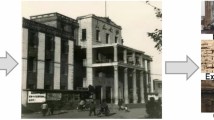Abstract
This study focused on porous lightweight clay bricks as a construction material as opposed to autoclaved aerated concrete and pumice blocks. Traditional clay bricks exhibit good stability against environmental conditions and are an economical alternative compared to other construction materials. Furthermore, clay bricks have better mechanical properties than autoclaved aerated concrete and pumice blocks but poorer thermal insulation properties; hence, their use in buildings is becoming increasingly unfavourable. This study focused on developing porous lightweight clay bricks with relatively better thermal insulation properties using a replication method.







Similar content being viewed by others
Abbreviations
- AAC:
-
Autoclaved aerated concrete
- PB:
-
Pumice blocks
- PLCB:
-
Porous lightweight clay bricks
References
Gredmaier, L., Banks, C.J., Pearce, R.B.: Calcium and sulphur distribution in red clay brick in the presence of a black reduction core using micro X-ray fluorescence mapping. Constr Build Mater. 25(12), 4477–4486 (2011)
Chiang, K.Y., Chou, P.H., Hua, C.R., Chien, K.L., Cheeseman, C.: Lightweight bricks manufactured from water treatment sludge and rice husks. J Hazard Mater. 171, 76–82 (2009)
Veiseh, S., Yousefi, A.A.: The use of polystyrene in lightweight brick production. Iran Polym J. 12(4), 323–329 (2003)
Akpınar, S., Altun, A., Önel, K.: Characterization and determination of certain mechanical properties of cordierite based silicon carbide added foam filters, www.serfed.com/content_files/dergi/29/140-146-bilimmakale.pdf
Kazmi, S.M.S., Abbas, S., Saleem, M.A., Munir, M.J., Khitab, A.: Manufacturing of sustainable clay bricks: utilization of waste sugarcane bagasse and rice husk ashes. Constr Build Mater. 120, 29–41 (2016)
Vodova, L., Sokolar, R., Hroudova, J.: The effect of CaO addition on mechanical properties of ceramic tiles, International Journal of Civil, Environmental, Structural. Constr Archit Eng. 8(6), 717–720 (2014)
Cultrone, G., Sebastian, E., Elert, K., Jose de la Torre, M., Cazalla, O., CRodriguez-Navarro, C.: Influence of mineralogy and firing temperature on the porosity of bricks. J. Eur. Ceram. Soc. 24, 547–564 (2004)
Eltmimi, A.H., Barron, L., Rafferty, A., Hanrahan, J.P., Fedyanina, O., Nesterenko, E., Nesterenko, P.N., Paul, B.: Preparation, characterisation and modification of carbon-based monolithic rods for chromatographic applications. J Sep Sci. 33, 1231–1243 (2010)
Sütçü, M., Akkurt, S.: The use of recycled paper processing residues in making porous brick with reduced thermal conductivity. Ceram Int. 35, 2625–2631 (2009)
Görhan, G., Simsek, O.: Porous clay bricks manufactured with rice husks. Constr Build Mater. 40, 390–396 (2013)
TS 825, Binalarda ısı yalıtım kuralları (Thermal insulation requirements for buildings) .TSE. Ankara – Turkey. (2008)
Pabst, W., Gregorová, E.: Conductivity of porous materials with spheroidal pores. J. Eur. Ceram. Soc., 34, 2757–2766 (2014)
Liu, J., Li, Y., Li, Y., Sang, S., Li, S.: Effects of pore structure on thermal conductivity and strength of alumina porous ceramics using carbon black as pore-forming agent. Ceram Int. 42(7), 8221–8228 (2016)
Cultrone, G., Sidraba, I., Sebastian, E.: Mineralogical and physical characterization of the bricks used in the construction of the “Triangul Bastion”, Riga (Latvia). Appl Clay Sci. 28, 297–308 (2005)
Acknowledgements
The author would like to thank Assit. Prof. Dr. Zuhtu Onur Pehlivanli for carrying out the thermal conductivity measurements (Kirikkale University, Kirikkale, Turkey).
This research project was supported by Kirikkale University (Project No. 2016/139).
Author information
Authors and Affiliations
Corresponding author
Rights and permissions
About this article
Cite this article
Aydin, T. Development of porous lightweight clay bricks using a replication method. J Aust Ceram Soc 54, 169–175 (2018). https://doi.org/10.1007/s41779-017-0138-3
Received:
Revised:
Accepted:
Published:
Issue Date:
DOI: https://doi.org/10.1007/s41779-017-0138-3




